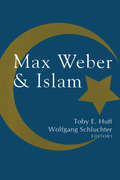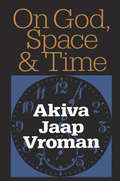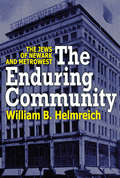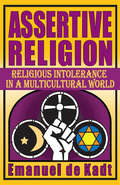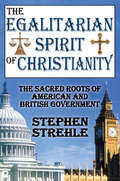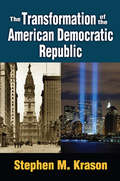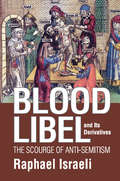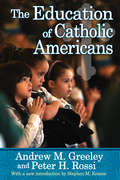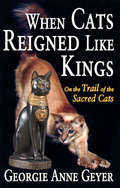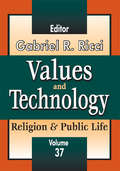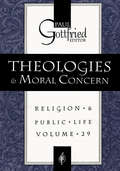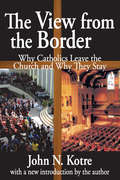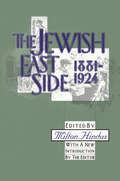- Table View
- List View
Max Weber and Islam
by Wolfgang SchluchterMax Weber and Islam is a major effort by Islamic-studies specialists to reexamine and appraise Max Weber's perspectives on Islam and its historical development. Eight specialists on Islam and two sociologists explore many dimensions of Weber's comments on Islam, along with Weber's conceptual framework. The volume's introduction links the discussions to contemporary issues and debates.Wolfgang Schluchter reconstructs Weber's conceptual apparatus as it applies to Islam and its historical development. In subsequent chapters, Islamic specialists consider such major topics as the developmental history of Islam, Islamic fundamentalism, Islamic reform, Islamic law and capitalism, secularization in Islam, as well as the value of attempting to apply Weber's concept of sects to Islam. While some authors find flaws in Weber's factual knowledge of Islam, they also find considerable merit in the kinds of questions Weber raised.Contributors to the volume include highly respected contemporary international scholars of Islam: Ira Lapidus, Nehemia Levtzion, Richard M. Eaton, Peter Hardy, Rudolph Peters, Barbara Metcalf, Francis Robinson, Patricia Crone, Michael Cook, and S.N. Eisenstadt. Toby Huff's introduction not only knits the thematics of the separate essays together but adds its own stresses while engaging the contributors in dialogue and debate about fundamental issues. This acute collective analysis establishes a new benchmark for understanding Weber and Islam. This book also provides an up-to-date overview of the developmental history of many aspects of Islam. A major reappraisal of the entire span of Max Weber's sociological thought on Islam, this book will appeal to a wide range of scholars and laymen interested in the Islamic world. It will be of particular interest to sociologists specializing in religion and Middle East area specialists.
On God, Space, and Time
by Akiva VromanFor Akiva Jaap Vroman "a day in the infinite past" is nonsense. All the days that have elapsed belong to a past of countable days; they started on a first day a finite number of days ago. Time began this first day. It follows that an eternal past does not exist. Vroman bases his reasoning on a simple mathematical law: an infinite quantity remains the same infinite quantity if a finite quantity, however large, is subtracted from it. On God, Space, and Time devotes itself to this proof.On God, Space, and Time is rooted in the epistemological thinking of Immanuel Kant and Jean Piaget and the law of Leucippus, and draws from the somewhat disparate fields of psychology, physiology, mathematics, and physics.
On God, Space, and Time
by Akiva VromanFor Akiva Jaap Vroman "a day in the infinite past" is nonsense. All the days that have elapsed belong to a past of countable days; they started on a first day a finite number of days ago. Time began this first day. It follows that an eternal past does not exist. Vroman bases his reasoning on a simple mathematical law: an infinite quantity remains the same infinite quantity if a finite quantity, however large, is subtracted from it. On God, Space, and Time devotes itself to this proof.On God, Space, and Time is rooted in the epistemological thinking of Immanuel Kant and Jean Piaget and the law of Leucippus, and draws from the somewhat disparate fields of psychology, physiology, mathematics, and physics.
The Enduring Community: The Jews of Newark and MetroWest
by William B. HelmreichFrom its founding in the late seventeenth century, Newark, New Jersey, was a vibrant and representative center of Jewish life in America. Geographically and culturally situated between New York City and its outlying suburbs, Newark afforded Jewish residents the advantages of a close-knit community along with the cultural abundance and social dynamism of urban life. In Newark, all of the representative stages of modern Jewish experience were enacted, from immigration and acculturation to upward mobility and community building. The Enduring Community is a lively and evocative social history of the Jewish presence in Newark as well as an examination of what Newark tells us about social assimilation, conflict and change.Grounded in documentary research, the volume makes extensive use of interviews and oral histories. The author traces the growth of the Jewish population in the pre-Revolutionary period to its settlement of German Jews in the 1840s and Eastern European Jews in the 1880s. Helmreich delineates areas of contention and cooperation between these groups and relates how an American identity was eventually forged within the larger ethnic mix of the city. Jewish population in politics, the establishment of Jewish schools, synagogues, labor unions, charities, and community groups are described together with cultural and recreational life. Despite the formal and emotional bonds that formed over a century, Jewish neighborhoods in Newark did not survive the postwar era. The trek to the suburbs, the erosion of Newark's tax base, and deteriorating services accelerated a movement outward that mirrored the demographic patterns of cities across America. By the time of the Newark riots in 1967, the Jewish presence was largely absent.This volume reclaims a lost history and gives personalized voice to the dreams, aspirations, and memories of a dispersed community. It demonstrates how former Newarkers built new Jewish communities in the surrounding suburbs, an area dubbed "MetroWest" by Jewish leaders. The Enduring Community is must reading for students of Jewish social history, sociologists, urban studies specialists, and readers interested in the history of New Jersey. The book includes archival photographs form the periods discussed.
The Enduring Community: The Jews of Newark and MetroWest
by William HelmreichFrom its founding in the late seventeenth century, Newark, New Jersey, was a vibrant and representative center of Jewish life in America. Geographically and culturally situated between New York City and its outlying suburbs, Newark afforded Jewish residents the advantages of a close-knit community along with the cultural abundance and social dynamism of urban life. In Newark, all of the representative stages of modern Jewish experience were enacted, from immigration and acculturation to upward mobility and community building. The Enduring Community is a lively and evocative social history of the Jewish presence in Newark as well as an examination of what Newark tells us about social assimilation, conflict and change.Grounded in documentary research, the volume makes extensive use of interviews and oral histories. The author traces the growth of the Jewish population in the pre-Revolutionary period to its settlement of German Jews in the 1840s and Eastern European Jews in the 1880s. Helmreich delineates areas of contention and cooperation between these groups and relates how an American identity was eventually forged within the larger ethnic mix of the city. Jewish population in politics, the establishment of Jewish schools, synagogues, labor unions, charities, and community groups are described together with cultural and recreational life. Despite the formal and emotional bonds that formed over a century, Jewish neighborhoods in Newark did not survive the postwar era. The trek to the suburbs, the erosion of Newark's tax base, and deteriorating services accelerated a movement outward that mirrored the demographic patterns of cities across America. By the time of the Newark riots in 1967, the Jewish presence was largely absent.This volume reclaims a lost history and gives personalized voice to the dreams, aspirations, and memories of a dispersed community. It demonstrates how former Newarkers built new Jewish communities in the surrounding suburbs, an area dubbed "MetroWest" by Jewish leaders. The Enduring Community is must reading for students of Jewish social history, sociologists, urban studies specialists, and readers interested in the history of New Jersey. The book includes archival photographs form the periods discussed.
Assertive Religion: Religious Intolerance in a Multicultural World
by Emanuel de KadtQuestions about religions and religious institutions have changed dramatically since they first arose many years ago. In the beginning of the twenty-first century, the link of religion with extreme ideologies captures our attention. Such questions have been the focus of a steadily growing number of books. What does Assertive Religion add to the debate?Emanuel de Kadt discusses the relationship of religion to wider social issues such as human rights and multiculturalism. He traces the growth, during the religious revival over the past decades, of assertive, and even coercive, forms of religion, notably—but not exclusively—fundamentalist varieties. He deals with these questions as they relate to the three major Abrahamic religions, thereby addressing a readership wider than that made up of persons interested exclusively in Judaism, Christianity, or Islam.The author takes on issues such as the effects of the "Jewishness" of Israel on the rights of Palestinians; the consequences of the centralized authority structure of the Roman Catholic Church; and the implications of the failure of reform-oriented Muslims to make their voices heard in an organized Islamic reform movement. He is even-handed, focusing on both positive and negative features of each religious perspective, though he does have a clear viewpoint. Assertive Religion adds to increasingly sharp political discussions on issues arising out of religion. It is a must read for anyone interested in how religion is shaping the world of tomorrow.
Assertive Religion: Religious Intolerance in a Multicultural World
by Emanuel de KadtQuestions about religions and religious institutions have changed dramatically since they first arose many years ago. In the beginning of the twenty-first century, the link of religion with extreme ideologies captures our attention. Such questions have been the focus of a steadily growing number of books. What does Assertive Religion add to the debate?Emanuel de Kadt discusses the relationship of religion to wider social issues such as human rights and multiculturalism. He traces the growth, during the religious revival over the past decades, of assertive, and even coercive, forms of religion, notably—but not exclusively—fundamentalist varieties. He deals with these questions as they relate to the three major Abrahamic religions, thereby addressing a readership wider than that made up of persons interested exclusively in Judaism, Christianity, or Islam.The author takes on issues such as the effects of the "Jewishness" of Israel on the rights of Palestinians; the consequences of the centralized authority structure of the Roman Catholic Church; and the implications of the failure of reform-oriented Muslims to make their voices heard in an organized Islamic reform movement. He is even-handed, focusing on both positive and negative features of each religious perspective, though he does have a clear viewpoint. Assertive Religion adds to increasingly sharp political discussions on issues arising out of religion. It is a must read for anyone interested in how religion is shaping the world of tomorrow.
The Egalitarian Spirit of Christianity: The Sacred Roots of American and British Government
by Stephen StrehleReligion no longer plays a dominant role in the everyday consciousness of modern Western society. Few people recognize the underlying role of religious beliefs and practices in their life choices. Stephen Strehle shows the significance and ongoing influence of religion in contemporary life by revealing the sacred roots of modern political ideas in the sixteenth and seventeenth centuries. He discusses the role of the church in government, probing into the sources of democratic, federal, and egalitarian ideas on the continent of Europe during the Reformation. The separation of church and state in America and the diminished power of the Church of England were the culmination of secular forces evolving since the Enlightenment. This secular view of life represents the basic mentality of the culture and the government in general; yet there is much to contradict it. The last half of the twentieth century witnessed a surge of grassroots movements from all sides of the political/religious spectrum. These included the civil rights movement of the 1960s and the Moral Majority of the 1980s, both of which provided an effective challenge to a simple separation of the two realms. Strehle explores some of the most cherished political ideals of modern society, including equality and democracy, liberty and natural rights, progress and capitalism, federalism and mixed government. He does not dismiss the vital contribution of other possible sources of inspiration from the world of religion or undermine the well-established place of &“secular&” sources. But he does show that certain ideas associated with the religious community have left an indelible mark upon significant aspects of the emerging American landscape.
The Egalitarian Spirit of Christianity: The Sacred Roots of American and British Government
by Stephen StrehleReligion no longer plays a dominant role in the everyday consciousness of modern Western society. Few people recognize the underlying role of religious beliefs and practices in their life choices. Stephen Strehle shows the significance and ongoing influence of religion in contemporary life by revealing the sacred roots of modern political ideas in the sixteenth and seventeenth centuries. He discusses the role of the church in government, probing into the sources of democratic, federal, and egalitarian ideas on the continent of Europe during the Reformation. The separation of church and state in America and the diminished power of the Church of England were the culmination of secular forces evolving since the Enlightenment. This secular view of life represents the basic mentality of the culture and the government in general; yet there is much to contradict it. The last half of the twentieth century witnessed a surge of grassroots movements from all sides of the political/religious spectrum. These included the civil rights movement of the 1960s and the Moral Majority of the 1980s, both of which provided an effective challenge to a simple separation of the two realms. Strehle explores some of the most cherished political ideals of modern society, including equality and democracy, liberty and natural rights, progress and capitalism, federalism and mixed government. He does not dismiss the vital contribution of other possible sources of inspiration from the world of religion or undermine the well-established place of &“secular&” sources. But he does show that certain ideas associated with the religious community have left an indelible mark upon significant aspects of the emerging American landscape.
The Transformation of the American Democratic Republic
by Stephen M. KrasonIn this stimulating volume, Stephen M. Krason considers whether the Founding Fathers' vision of the American democratic republic has been transformed and if so, in what ways. He looks to the basic principles of the Founding Fathers, then discusses the changes that resulted from evolving contemporary expectations about government. Referencing philosophical principles and the work of great Western thinkers, Krason then explores a variety of proposals that could forge a foundation for restoration.Acknowledging that any attempt to revive the Founders' views on a democratic republic must start in the public sphere, Krason focuses on concerned citizens who are aware of the extent to which our current political structures deviate from the Founders' vision and want to take action. Ultimately, a democratic republic can exist, be sustained, and flourish only when there is a deep commitment to it in the minds and norms of its people.Written by a foremost authority in the field of US Constitutional law, this book will appeal to those interested in American history, society, and politics.
The Transformation of the American Democratic Republic
by Stephen M. KrasonIn this stimulating volume, Stephen M. Krason considers whether the Founding Fathers' vision of the American democratic republic has been transformed and if so, in what ways. He looks to the basic principles of the Founding Fathers, then discusses the changes that resulted from evolving contemporary expectations about government. Referencing philosophical principles and the work of great Western thinkers, Krason then explores a variety of proposals that could forge a foundation for restoration.Acknowledging that any attempt to revive the Founders' views on a democratic republic must start in the public sphere, Krason focuses on concerned citizens who are aware of the extent to which our current political structures deviate from the Founders' vision and want to take action. Ultimately, a democratic republic can exist, be sustained, and flourish only when there is a deep commitment to it in the minds and norms of its people.Written by a foremost authority in the field of US Constitutional law, this book will appeal to those interested in American history, society, and politics.
Blood Libel and Its Derivatives: The Scourge of Anti-Semitism
by Raphael IsraeliAt the doorstep of the twenty-first century, one would expect that medieval concepts such as blood libel—the accusation that Jews kill children to use their blood in religious ritual—would have been discarded by any civilized human being. Certainly in the Christian world, where the story originated and endured for centuries, modern attitudes have nearly erased these barbaric accusations. But in Arab and Islamic worlds, where enmity towards Israel and Zionism has conditioned beliefs, attitudes, positions, and fantasies, blood libel and similar charges are still part of life.Most people are unaware of the history of blood libel and do not perceive links between it and many of the false accusations currently hurled against the state of Israel. Raphael Israeli argues that individuals and organizations guilty of human rights crimes project crimes onto Israel to avoid awareness of their own guilt. Certainly when countries ruled by dictators set the agenda of the UN Council for human rights, Israel is consistently censured and condemned.Accusations of "apartheid" and charges of discrimination against Muslims are frequently made. Israel is accused of plots against Muslims in order to harm their productive sectors, of using weapons of mass destruction to commit "genocide" against Arabs, of injecting poisonous substances into Palestinian children, of poisoning Arab lands under the guise of "agricultural aid," and of laying siege to peaceful citizens. All of these charges are derivatives of blood libel and have been adopted by Middle East Jihadists in their struggle against Israel. This volume aims to explain the origins of the charge of blood libel and define the ways its derivatives have achieved acceptance in certain parts of the world today.
Blood Libel and Its Derivatives: The Scourge of Anti-Semitism
by Raphael IsraeliAt the doorstep of the twenty-first century, one would expect that medieval concepts such as blood libel—the accusation that Jews kill children to use their blood in religious ritual—would have been discarded by any civilized human being. Certainly in the Christian world, where the story originated and endured for centuries, modern attitudes have nearly erased these barbaric accusations. But in Arab and Islamic worlds, where enmity towards Israel and Zionism has conditioned beliefs, attitudes, positions, and fantasies, blood libel and similar charges are still part of life.Most people are unaware of the history of blood libel and do not perceive links between it and many of the false accusations currently hurled against the state of Israel. Raphael Israeli argues that individuals and organizations guilty of human rights crimes project crimes onto Israel to avoid awareness of their own guilt. Certainly when countries ruled by dictators set the agenda of the UN Council for human rights, Israel is consistently censured and condemned.Accusations of "apartheid" and charges of discrimination against Muslims are frequently made. Israel is accused of plots against Muslims in order to harm their productive sectors, of using weapons of mass destruction to commit "genocide" against Arabs, of injecting poisonous substances into Palestinian children, of poisoning Arab lands under the guise of "agricultural aid," and of laying siege to peaceful citizens. All of these charges are derivatives of blood libel and have been adopted by Middle East Jihadists in their struggle against Israel. This volume aims to explain the origins of the charge of blood libel and define the ways its derivatives have achieved acceptance in certain parts of the world today.
The Education of Catholic Americans
by Andrew M. GreeleyFirst Published in 2017. Routledge is an imprint of Taylor & Francis, an Informa company.
The Education of Catholic Americans
by Andrew M. GreeleyFirst Published in 2017. Routledge is an imprint of Taylor & Francis, an Informa company.
When Cats Reigned Like Kings: On the Trail of the Sacred Cats
by Georgie Anne GeyerIn her fascinating exploration of feline history, Georgie Anne Geyer explores the connections between the royal and sacred felines of ancient civilizations and the beloved domestic cats of today. Chasing an irresistible mystery across the globe, Geyer conducts exhaustive research into the little-known puzzle of how cats came to occupy their unique position in the lives of humans. Treated with the tenacity, resourcefulness, and narrative instinct of a seasoned foreign correspondent, the investigation yields unexpected answers and poses tantalizing new questions.It was Geyer's curiosity about her own cats that inspired her to study the history of human-feline relations and especially the exalted status of cats among the ancients as royal or sacred beings. In Egypt, Geyer learned of the cat-goddess Bastet and of the cat's role in the transmigration of souls. In Myanmar she saw Leonardo DiCaprio, Ricky Martin, and the other incongruously named cats of the Nga Phe Kyaung monastery, trained by the monks to jump through hoops. She even met a family who dutifully guards the heritage of the Japanese Bobtail, cultivating the line in of all places rural Virginia.Richly illustrated with photographs of Geyer's journeys and historical cat images, When Cats Reigned Like Kings describes forty-one recognized modern cat breeds plus other popular cats. Every cat lover can, thus, trace his or her cat to these breeds and their many relatives. The result is a remarkable book, bound to delight and amaze cat fanciers and adventure seekers.
When Cats Reigned Like Kings: On the Trail of the Sacred Cats
by Georgie Anne GeyerIn her fascinating exploration of feline history, Georgie Anne Geyer explores the connections between the royal and sacred felines of ancient civilizations and the beloved domestic cats of today. Chasing an irresistible mystery across the globe, Geyer conducts exhaustive research into the little-known puzzle of how cats came to occupy their unique position in the lives of humans. Treated with the tenacity, resourcefulness, and narrative instinct of a seasoned foreign correspondent, the investigation yields unexpected answers and poses tantalizing new questions.It was Geyer's curiosity about her own cats that inspired her to study the history of human-feline relations and especially the exalted status of cats among the ancients as royal or sacred beings. In Egypt, Geyer learned of the cat-goddess Bastet and of the cat's role in the transmigration of souls. In Myanmar she saw Leonardo DiCaprio, Ricky Martin, and the other incongruously named cats of the Nga Phe Kyaung monastery, trained by the monks to jump through hoops. She even met a family who dutifully guards the heritage of the Japanese Bobtail, cultivating the line in of all places rural Virginia.Richly illustrated with photographs of Geyer's journeys and historical cat images, When Cats Reigned Like Kings describes forty-one recognized modern cat breeds plus other popular cats. Every cat lover can, thus, trace his or her cat to these breeds and their many relatives. The result is a remarkable book, bound to delight and amaze cat fanciers and adventure seekers.
Values and Technology: Religion and Public Life (Religion And Public Life Ser.)
by James BurkIn 1749 Jean-Jacques Rousseau's Discourse on the Arts and Sciences, surprised leading Enlightenment thinkers who had enthusiastically upheld the positive benefits of humanity's technological advance. Voltaire, who celebrated the ends of civilization, mocked Rousseau's praise for an original creative state of nature in which man enjoyed an optimum level of freedom.Given the unprecedented intrusion of technology into our lives, the question raised by Rousseau's critique may be even more pertinent. In this volume of Religion and Public Life contributors address some of the challenges to conventional morality brought on by the technological augmentation of the social structure. John Barker's essay explores how Luciano Floridi's philosophy of technology has complicated the conventional way of determining what ought to receive moral consideration. Fani Zlatarova provides a practical guide for incorporating ethical components into teaching computer technology.Grant Havers explores the controversies surrounding the biogenetic explosion through an examination of the competing philosophical perspectives and Christopher Vassilopolos examines the science-based justification for taking life. Gabriel R. Ricci looks at recent political history in the United States in order to highlight the sometimes uneasy relationship between science and social policy. Volume 37 is a welcome addition to the acclaimed Religion and Public Life series.
Values and Technology: Religion and Public Life
by James BurkIn 1749 Jean-Jacques Rousseau's Discourse on the Arts and Sciences, surprised leading Enlightenment thinkers who had enthusiastically upheld the positive benefits of humanity's technological advance. Voltaire, who celebrated the ends of civilization, mocked Rousseau's praise for an original creative state of nature in which man enjoyed an optimum level of freedom.Given the unprecedented intrusion of technology into our lives, the question raised by Rousseau's critique may be even more pertinent. In this volume of Religion and Public Life contributors address some of the challenges to conventional morality brought on by the technological augmentation of the social structure. John Barker's essay explores how Luciano Floridi's philosophy of technology has complicated the conventional way of determining what ought to receive moral consideration. Fani Zlatarova provides a practical guide for incorporating ethical components into teaching computer technology.Grant Havers explores the controversies surrounding the biogenetic explosion through an examination of the competing philosophical perspectives and Christopher Vassilopolos examines the science-based justification for taking life. Gabriel R. Ricci looks at recent political history in the United States in order to highlight the sometimes uneasy relationship between science and social policy. Volume 37 is a welcome addition to the acclaimed Religion and Public Life series.
Theologies and Moral Concern
by Paul GottfriedThis is the twenty-ninth volume in This World, a series on religion and public affairs. It focuses on theological and moral questions of deep significance for our time. The lines of division separating secular and religious outlooks, modernity and postmodernism, and romantic and classical styles of thought are some of the topics treated in this volume. Additional features are an exchange of opinions and a position paper intended to generate further discussion. This ongoing series of volumes seeks to provide a wide-ranging forum for differing views on religious and ethical considerations.Theologies and Moral Concern include the following major contributions: "Distinctions of Power: How Church and State Divide America" by Brian Mitchell; "Beyond the Impasses: Making Moral Sense of Abortion" by Anthony Matteo; "Are Religions Ever Traditional" by Jacob Neusner; "Philosophical Issues in Darwinian Theory" by Kenneth T. Gallagher; "Monotheism and Skepticism" by Aryeh Botwinick; "Defining Romantic Theology" by Gerhard Spiegler; and "The YMCA and Suburban America" by Clifford Putney. In addition, the volume features a dialogue between Michael A. Weinstein and Paul Gottfried on what constitutes the proper role for liberal arts education in contemporary American society as well as a position paper titled "The Pitfalls of Political Correctness" by Lawrence Nannery.Theologies and Moral Concern is part of an annual survey of religion and public life which aims to provide relevant information and ideas about significant issues of the day. It is directly pertinent to understanding the connection between religion and the state. This particular volume, coming at a time of intense public scrutiny of fundamentalism, evangelicism, and new religious movements generally, should have special appeal for political scientists, American studies specialists, sociologists, and those involved in the creation of public policy.
Theologies and Moral Concern
by Paul GottfriedThis is the twenty-ninth volume in This World, a series on religion and public affairs. It focuses on theological and moral questions of deep significance for our time. The lines of division separating secular and religious outlooks, modernity and postmodernism, and romantic and classical styles of thought are some of the topics treated in this volume. Additional features are an exchange of opinions and a position paper intended to generate further discussion. This ongoing series of volumes seeks to provide a wide-ranging forum for differing views on religious and ethical considerations.Theologies and Moral Concern include the following major contributions: "Distinctions of Power: How Church and State Divide America" by Brian Mitchell; "Beyond the Impasses: Making Moral Sense of Abortion" by Anthony Matteo; "Are Religions Ever Traditional" by Jacob Neusner; "Philosophical Issues in Darwinian Theory" by Kenneth T. Gallagher; "Monotheism and Skepticism" by Aryeh Botwinick; "Defining Romantic Theology" by Gerhard Spiegler; and "The YMCA and Suburban America" by Clifford Putney. In addition, the volume features a dialogue between Michael A. Weinstein and Paul Gottfried on what constitutes the proper role for liberal arts education in contemporary American society as well as a position paper titled "The Pitfalls of Political Correctness" by Lawrence Nannery.Theologies and Moral Concern is part of an annual survey of religion and public life which aims to provide relevant information and ideas about significant issues of the day. It is directly pertinent to understanding the connection between religion and the state. This particular volume, coming at a time of intense public scrutiny of fundamentalism, evangelicism, and new religious movements generally, should have special appeal for political scientists, American studies specialists, sociologists, and those involved in the creation of public policy.
The View from the Border: Why Catholics Leave the Church and Why They Stay
by John KotreIn this unique psychological study, John Kotre provides some startling answers to the questions Catholics are now asking about those who abandon the church, those who remain in it, and those who attempt to create a new church within the church. A detailed examination of the borderline between membership and ex-membership in the Catholic Church, as perceived by young adults reared within the Catholic educational system, the book provides an impressive substantive contribution to understanding not only of the modern church, but of organizational change in general.Kotre, himself a product of the Catholic educational system, positions himself amid the tension and ambiguity between those who consider themselves "in" and those who consider themselves "out" of the Catholic Church. He designed a systematic questionnaire covering four hundred variables about each subject's beliefs, values, perceptions of parents, and reasons for being an insider or an outsider. Using this questionnaire he individually interviewed one hundred graduates of Catholic colleges. The surprising results of this important research show that, in spite of sixteen years of formal Catholic education, the attitudes of both the "ins" and the "outs" are not influenced by their Catholic upbringing so much as by their primary group relationships.Recent research has shown that adult Americans are leaving their childhood faiths at ever increasing rates and that the Catholic Church is suffering the greatest losses. Kotre's book offers an insightful psychological perspective on this dramatic movement. It is a must-read for professional psychologists and sociologists, theologians, and people interested in the psychology and sociology of religion.
The View from the Border: Why Catholics Leave the Church and Why They Stay
by John KotreIn this unique psychological study, John Kotre provides some startling answers to the questions Catholics are now asking about those who abandon the church, those who remain in it, and those who attempt to create a new church within the church. A detailed examination of the borderline between membership and ex-membership in the Catholic Church, as perceived by young adults reared within the Catholic educational system, the book provides an impressive substantive contribution to understanding not only of the modern church, but of organizational change in general.Kotre, himself a product of the Catholic educational system, positions himself amid the tension and ambiguity between those who consider themselves "in" and those who consider themselves "out" of the Catholic Church. He designed a systematic questionnaire covering four hundred variables about each subject's beliefs, values, perceptions of parents, and reasons for being an insider or an outsider. Using this questionnaire he individually interviewed one hundred graduates of Catholic colleges. The surprising results of this important research show that, in spite of sixteen years of formal Catholic education, the attitudes of both the "ins" and the "outs" are not influenced by their Catholic upbringing so much as by their primary group relationships.Recent research has shown that adult Americans are leaving their childhood faiths at ever increasing rates and that the Catholic Church is suffering the greatest losses. Kotre's book offers an insightful psychological perspective on this dramatic movement. It is a must-read for professional psychologists and sociologists, theologians, and people interested in the psychology and sociology of religion.
The Jewish East Side: 1881-1924 (The Library of Conservative Thought)
by Milton HindusThis book, originally published as The Old East Side, is a collection of literature and documents ranging from the autobiography of the sculptor Jacob Epstein and the novels of Abraham Cahan to the reporting of William Dean Howells and the fictional reconstruction of a vanished world by Henry Roth. The world is that of the old shtetl transplanted to a new, growing country, where "the ghetto" (in the years 1881-1924) was an unstable mixture of nostalgic elements and the pressures of American economic and social reality.The productivity, both intellectual and material, of the section of New York known as the East Side during those forty years around the turn of the twentieth century has become a legend among many Jews in this country and deserves to become better known to many more of other ethnic origins. The lower East Side was paradoxically a wilderness to be traversed and a portion of that "promised land" which had been glimpsed with so much hope from afar. To wonderfully talented and observant children, like Jacob Epstein, the streets there in the 1880s were as filled with excitement as those of the Arabian Nights. To serious philosophic young men like Morris Raphael Cohen, they were as challenging as the marketplace of Athens had once been to Socrates to achieve intellectual enlightenment and the improvement of the social order.The conditions of abominable crowding and poverty described in the sociological tracts of Jacob Riis, Lillian Wald, and others are better known perhaps to the average reader than the accounts of such pleasures as the dancing schools, the Yiddish theaters, the cafes, the lectures, the literary ferment and activities, described in the pages of Abraham Cahan and Hutchins Hapgood. But all the views presented in The Jewish East Side, both dark and bright, are recognizably parts of the same picture. This book will be of value to sociologists, historians, researchers specializing in Judaic studies, and students of literature.
The Jewish East Side: 1881-1924 (The Library of Conservative Thought)
by Milton HindusThis book, originally published as The Old East Side, is a collection of literature and documents ranging from the autobiography of the sculptor Jacob Epstein and the novels of Abraham Cahan to the reporting of William Dean Howells and the fictional reconstruction of a vanished world by Henry Roth. The world is that of the old shtetl transplanted to a new, growing country, where "the ghetto" (in the years 1881-1924) was an unstable mixture of nostalgic elements and the pressures of American economic and social reality.The productivity, both intellectual and material, of the section of New York known as the East Side during those forty years around the turn of the twentieth century has become a legend among many Jews in this country and deserves to become better known to many more of other ethnic origins. The lower East Side was paradoxically a wilderness to be traversed and a portion of that "promised land" which had been glimpsed with so much hope from afar. To wonderfully talented and observant children, like Jacob Epstein, the streets there in the 1880s were as filled with excitement as those of the Arabian Nights. To serious philosophic young men like Morris Raphael Cohen, they were as challenging as the marketplace of Athens had once been to Socrates to achieve intellectual enlightenment and the improvement of the social order.The conditions of abominable crowding and poverty described in the sociological tracts of Jacob Riis, Lillian Wald, and others are better known perhaps to the average reader than the accounts of such pleasures as the dancing schools, the Yiddish theaters, the cafes, the lectures, the literary ferment and activities, described in the pages of Abraham Cahan and Hutchins Hapgood. But all the views presented in The Jewish East Side, both dark and bright, are recognizably parts of the same picture. This book will be of value to sociologists, historians, researchers specializing in Judaic studies, and students of literature.
